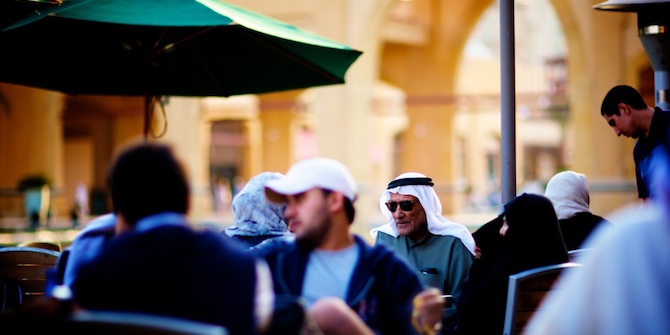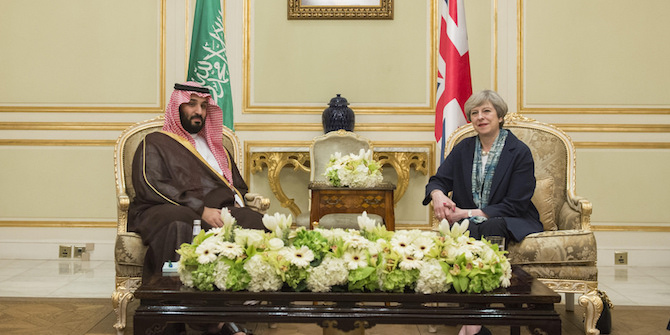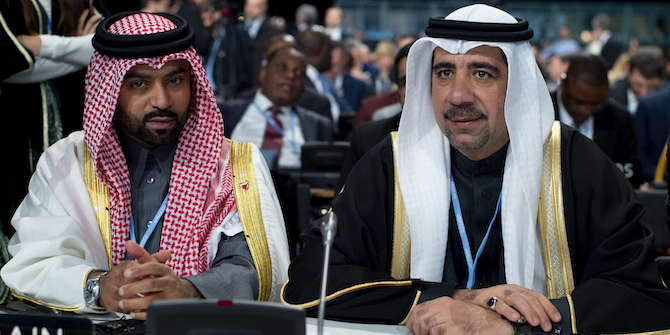by Karen Young
This memo was presented at a workshop organised by the LSE Middle East Centre on ‘Mapping GCC Foreign Policy: Resources, Recipients and Regional Effects‘ on 7 October 2015.
The Arab Gulf states (AGS), or the member states of the Gulf Cooperation Council, have historically used foreign aid and humanitarian aid as a quiet tool of foreign policy. More recently, however, we have seen targeted financial aid and military assistance by these states, particularly Saudi Arabia, Qatar and the United Arab Emirates, towards neighbours in crisis. Financial and military aid is used to jockey for influence within Egypt’s evolving political leadership, to attempt to remove Syria’s Assad from power, to counter the growth of the Islamic State movement in Iraq, to influence political battles in Libya, and even in newly democratic Tunisia. Windfalls in wealth generated from the rapid ascent of oil and gas prices between 2003 and 2014 allowed budgets to expand for both military expenditure and financial aid. The dramatic fall in oil prices in late 2014 raises questions about the ability of these states to continue their generosity and the exercise of economic statecraft in the MENA region.
The growing trend is that Gulf Arab states are willing to export their own political economy models, as a challenge to Western advice and hegemony, in their strategic efforts to limit political competition – especially political space – that is tolerant to activist religious political organisation or political Islam. General El-Sisi, in his address to potential investors at Sharm el Sheikh, called Egypt ‘the first line of defence’ against regional terrorism, and therefore a good place to invest. Strategies such as the use of oil and gas products as aid in kind, the targeting of construction and real estate as both investment vehicles (for state and private sector firms) and employment strategies, and the manipulation of central banks as quick fixes to a depreciating currency all relate to Gulf practices in economic governance.
The oil boom of 2003-2014 created an aid dilemma for Gulf Arab states. The largesse of the early 1970s was not to be repeated, either because state priorities (and constituent demands) for domestic spending had increased or because the states saw little reward in the exercise of aid to gain prominence in international institutions or to acquire allies in other developing states. According to the International Monetary Fund (IMF), GCC official reserves increased from $53.5 billion in 2003 to $514.3 billion in 2008, yet foreign aid increased only modestly, back to levels of the late 1980s.
Theoretical and Practical Implications of Gulf Arab Foreign Aid
Foreign aid is clearly a priority of Gulf Arab state foreign policy; aid creates alliances and upholds friendly regimes. However, foreign aid’s track record for efficacy, at least in the comparative experience of Western donors to developing countries, is questionable. Like a resource curse, aid can act as an exogenous shock to developing political economies, entrenching problems in governance and financial volatility, even as it seeks to alleviate human suffering. Governments seeking to promote strategic goals have had little success in also creating incentives for liberal economic reform agendas in aid destinations. Aid creates allies, or it might propel reform and economic growth, but not usually at the same time.
Foreign aid can extend the tenure of inept and corrupt rulers and governments. New work on the relationship between foreign aid and countries experiencing terrorism and domestic unrest reveals some interesting correlations. Piotr Lis finds that while armed conflict has a negative effect on the amounts of both bilateral and multilateral aid, recipient states combatting terrorism tend to see increased foreign assistance. This foreign assistance, however, tends to be bilateral and more closely linked to the donor country’s own strategic goals in countering violent extremism. Surprisingly however, the results do not hold for Muslim majority countries when they are sites of terrorist acts.
The implication is that Western aid strategies might be leaving a vacuum in Muslim majority states that are sites of terrorist threat (and/or domestic unrest), creating openings for other states to provide aid and strategic alliances. This might partially explain why we see a demand for Gulf state aid to these Muslim countries.
The trend among OECD donors, however, is to continue to provide high volumes of aid to countries with poor governance with the caveat of bypassing state institutions. Furthermore, a new wave of Gulf state aid may diverge from other international donor practices in that it will be less tied to both fiscal and normative patterns. Even more compelling is emerging evidence that aid which targets states with both a terrorism problem and a penchant for repressive security tactics doesn’t seem to work, and may even increase episodes of state repression.
We might expect the influx of foreign aid from the Gulf to other states in the Middle East, particularly Egypt, to have some of these side effects. Aid from the GCC states may well fill gaps in the normative patterns and preferences of Western aid, though it is just as likely to reinforce support for governments with patronage practices and repressive tactics. The absence of aid partners for development and governance programming in Egypt is a direct result of the government’s effort to curtail civil society and shut down existing foreign-funded organisations. Even if significant Western aid partners were to donate to Egypt, there are few non-state institutions able to absorb the aid. We can certainly expect GCC aid to Egypt to entrench the Sisi administration’s security apparatus and enable repression of political opposition groups. The question becomes for how long and to what depths will the partnership between GCC donors and Egypt endure?
Just as the international context has changed among donors, so have their priorities in aid targets since the early 2000s; this is particularly the case in the domestic and sub-regional context of the Gulf states. Exacerbated by the regional upheaval after 2011 and subsequent fall in oil revenues in mid-2014, the bilateral tradition of Gulf aid is situated along with demands for domestic spending, including welfare benefits and infrastructure investment, at moments of incremental public concern for fiscal deficits and sustained lower energy prices.
The strategic aid priorities originating in the Gulf are generally quite different from those originating in the West. In the case of the UAE, the overwhelming priority has been a coordinated business and security ambition: what strengthens the position of the state, while also providing a quality investment? When state and economic interests dovetail, we see the hallmark of Arab Gulf state economic statecraft. Because of the heavy presence of state-related entities in Gulf economies, any aid decision is also an investment opportunity for state-linked firms to capitalise on bilateral ties.
UAE Aid and Investment Strategy Dovetails
This coordinated business and security strategy is perhaps the key feature of Emirati foreign policy and foreign aid policy. In recent author interviews with advisors to the UAE Ministry of Foreign Affairs there is a recurrent theme: return on investment. The return is not calculated as a pure financial figure, but includes market access, market dominance, priority over regional rivals in the investment/aid target space, and forward-looking opportunities for state-related entities to make profitable partnerships, often with a medium to long-term trajectory. Trade, investment, security and building a state identity within an international system are not exclusive strategic objectives.
Historical Links and Investments between the UAE and Egypt
There are long-standing ties between the UAE and Egypt in the bank sector, construction, energy, tourism, retail and agriculture. The structure of the Emirati economy has linked political and economic leadership. It is common to see members of the ruling families of the seven emirates on the boards of major financial and commercial interests. The linking of private and state interests is not necessarily to achieve foreign policy goals, but rather is a pattern of elite networks and informed consensus building. Goals of the economic and political elite are intertwined. When political intervention becomes a state priority, these investment ties become resources for economic statecraft. Through partnerships with commercial interests, the state is able to orchestrate a multivariate aid approach. In the case of Egypt, this has included food security, monetary stability, job creation in construction and low-skilled sectors through housing initiatives, and increased deal flow for the local bank sector.
One of the advantages of small state networks is a tightened circle, a modern majilis, of financial and commercial advisors for the state. For the UAE, this circle is pressed by the state to support its foreign policy objectives concentrated in one very difficult market, Egypt. It remains to be seen whether the profit motive or the state power motive will dominate. There are early indications that the state is willing to scale back investment promises and commitments via commercial engagement when the profit motive is disappointing. The case of Arabtec investment in Egypt has been an important example of this tension.
Conclusion
Gulf Arab states are probably in a good position to create foreign aid projects with novel approaches to job creation and public-private partnerships. However, that success depends on the strategic goals of Gulf Arab states in their aid portfolios. If security is their primary concern, we should not expect to see great economic miracles (or political openings) unfolding across North Africa. Potential obstacles to increased or prolonged aid are more likely to be domestic pressures in the Gulf states themselves, based on fiscal concern, and blowback or policy reverberation in the form of domestic threats to state security.
Karen E. Young is a senior resident scholar at the Arab Gulf States Institute in Washington. She was research fellow at the LSE Middle East Centre from 2014-15, where she remains a visiting fellow. She tweets at @ProfessorKaren.
Other memos presented at the workshop
- Pejman Abdolmohammadi, ‘GCC-Iranian Relations and Changes in Iranian Foreign Policy towards its Neighbours’
- Suliman Al Atiqi, ‘GCC Foreign Policy Projections in the Palestinian-Israeli Conflict: A Comparative Analysis of Saudi Arabia & Qatar’
- Will Bartlett, James Ker-Lindsay, Kristian Alexander and Tena Prelec, ‘UAE Policies towards the Western Balkans: Investment Motives and Impacts’
- Courtney Freer, ‘Ikhwan Ascendant? Assessing the Influence of Domestic Islamist Sentiment on Qatari Foreign Policy’
- Christian Henderson, ‘The UAE’s Nexus State: Logistics, Transport and Foreign Policy’







